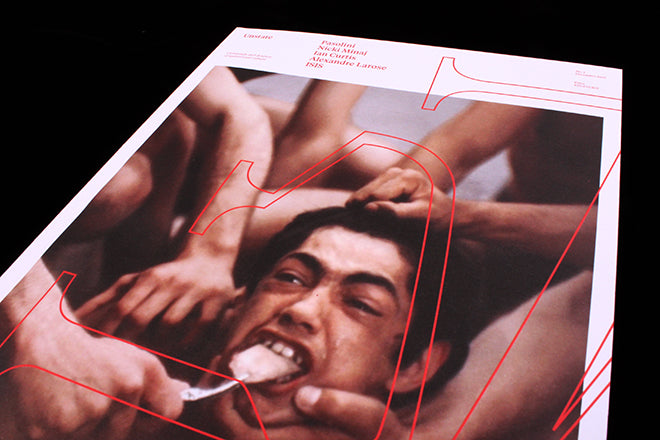
Unstate #1
As I write this I’ve just completed a talk about independent magazines for my friends Maison Moderne in Luxembourg. I ended the talk saying that the great thing about the new magazines is I’m forever being surprised, and this recent arrival is typical of the way a new project can do just that.
Like many new magazines, Unstate promises a unique perspective; unlike others it delivers. Dismissing the idea that a printed item is in some way definitive and certain in terms of content, the magazine mixes bold, imaginary thoughts with serious essays.
Covering all areas of image-making (‘cinema, photography, digital culture, illustration, video art, graphic humour, comic, urban art, and visual essays, etc,’ – I do like that ‘etc’) the editors take real stories and embellish them to see what happens. It reminds me of NME-era Paul Morley, drawing together seemingly disparate elements to forge possible truths that are obviously absurd yet challange the status quo.
 The opening essay immediately sets the tone, using Nicki Minaj as an unlikely thread to draw together the Lumiere Brothers’ first film experiments, Vinnie Jones’ violent treatment of Paul Gascoigne in a nineties football match and NATO leaders singing ‘We Are the World.’ Each element refers to a concrete image/event yet together it is nonsense; gorgeous, enoyable nonsense.
The opening essay immediately sets the tone, using Nicki Minaj as an unlikely thread to draw together the Lumiere Brothers’ first film experiments, Vinnie Jones’ violent treatment of Paul Gascoigne in a nineties football match and NATO leaders singing ‘We Are the World.’ Each element refers to a concrete image/event yet together it is nonsense; gorgeous, enoyable nonsense.
 A similar game is played later in the issue, when seperate interview answers from director Pier Paolo Passolini and singer Morrissey are combined to imply a conversation (above). The reason given for this ruse is that lyrics of the Morrissey song ‘You Have Killed Me’ mention Passolini.
A similar game is played later in the issue, when seperate interview answers from director Pier Paolo Passolini and singer Morrissey are combined to imply a conversation (above). The reason given for this ruse is that lyrics of the Morrissey song ‘You Have Killed Me’ mention Passolini.

My favourite piece concerns Joy Division singer Ian Curtis and his suicide the day before the band were due to visit the US. Their story and the storyline of Werner Herzog’s movie ‘Stroszek’ are pulled together in a complex tale pivoting on a scene in the movie ‘24 Hour Party People’, itself the story of Joy Division/Factory Records/Hacienda-era Manchester. Chuck in a few quotes from the Spice Girls and Maggie Thatcher (above) and you get a feeling for the scope of the games and interventions being played.
 There are plenty of images featured of course, carefully seperated from the texts. The contents page is in two parts – the first spread only images (above) the second text. But one of the great things about the magazine is the way it relies on describing images (rather than displaying them) in order to lead us astray. I can picture exactly the Vinnie Jones image, and though I’ve never seen it can imagine the NATO leaders singing. But did Nicki Minaj really appear in the Lumiere Brothers films? A few pages later, there’s the photographic ‘proof.’
There are plenty of images featured of course, carefully seperated from the texts. The contents page is in two parts – the first spread only images (above) the second text. But one of the great things about the magazine is the way it relies on describing images (rather than displaying them) in order to lead us astray. I can picture exactly the Vinnie Jones image, and though I’ve never seen it can imagine the NATO leaders singing. But did Nicki Minaj really appear in the Lumiere Brothers films? A few pages later, there’s the photographic ‘proof.’
Not everything is as playful; these stories sit between considered essays on the cunning simplicity of computer interfaces and the shifting meaning of public and private pictures in our social media age.
The design is smart and self-consciously serious – it is not always tonally appropriate yet ends up being perfect. It has an air of academia about it; each section opens with a bold red page and small heading and the typography throughout is tidily unspectacular. Fiction and non-fiction are blurred perfectly.
One final note: on first opening the issue I did that stick-my-nose-in-the-page thing to sniff the ink and paper and found the magazine absolutely stank. It really smells unpleasant. I’d love to confirm that was a deliberate bit of contrariness, it would suit Unstate perfectly.


